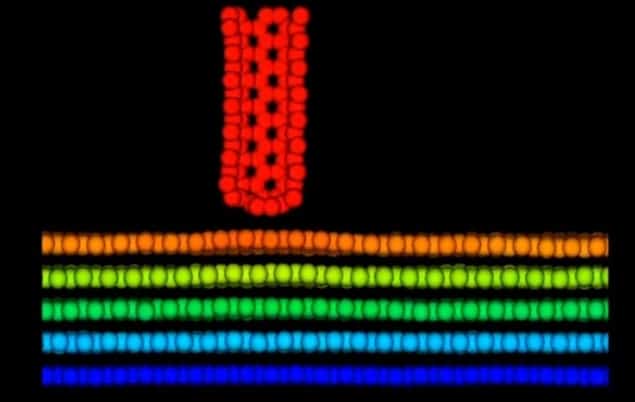
If you press your finger gently on a table and slide it across the surface, you will find that it glides fairly easily. If you press harder, it becomes more difficult to slide it as the firmer contact generates more friction. But now, researchers in the US and China have shown that if you do the same experiment with an atomic-force-microscope tip on a graphite surface, then you can see the exact opposite effect – friction decreases the harder you push.
For large objects such as fingers and tables, the friction between two surfaces results from surface roughness, impurities, oxide layers and numerous other effects. On the nanometre scale, however, individual atomic interactions become relevant. As a result, the laws of nanotribology – the study of nanoscale friction – can be very different from the friction we experience in the macroscopic world. For example, friction can sometimes vary periodically with the atomic lattice as an atomic force microscope (AFM) needle moves across a surface. Nanotribology is becoming increasingly important as scientists and engineers develop tiny nanomachines for a range of potential applications from assembling circuits to targeted drug delivery.
The coefficient of friction measures how friction changes as a function of load. It can be highly variable at the nanoscale, with friction increasing nonlinearly with load. However, it had never been known to be negative – that is, that friction increases as an object is pulled away from a surface.
Routine measurements
But that is exactly what Rachel Cannara, Zhao Deng and colleagues at the National Institute of Standards and Technology (NIST) in Maryland and Tsinghua University in Beijing have found. The unexpected discovery was made by Deng while measuring the friction between a diamond microscope tip and a graphite surface as a function of tip load – a routine measurement made by novice nanotribologists who are learning the tricks of the trade. “We were looking at various behaviours that are known to occur and repeating what has been shown in the literature,” explains Cannara.
When Deng increased the load on the needle, he found, as expected, that the friction increased. When he reduced the load again, however, there was a surprise. Instead of returning to its original value, the friction continued to rise. This would be similar to finding that the lighter you pressed on the table, the harder it became to slide your finger across it. This defied all theoretical predictions and is the first recorded instance of a material showing a negative frictional coefficient. The increase in friction continued as the load was reduced until the needle was completely detached from the surface.
So what was going on? Previous research has demonstrated that materials such as graphite that have a layered atomic structure generate more friction with the needle of an AFM when they are only a few atoms thick. This is thought to be because thinner materials are more flexible. When an atomically thin material touches an AFM tip, therefore, it deforms more than its thicker counterpart would, thus increasing the contact area and generating more friction.
A sticky surface?
Cannara’s group was working with bulk graphite, but the researchers suspect that when the needle was pressed into the surface of the material, the intermolecular attraction of the top few atomic layers towards the diamond tip was sufficient that when the load was reduced, these layers were lifted slightly away from the bulk graphite, sticking to the tip and generating friction. Only when the tip was removed completely did the graphite return to its initial state. Two different computer simulations showed that the hypothesis was plausible, although technical differences between the results still need to be resolved, says Cannara.
Robert Carpick, whose laboratory at the University of Pennsylvania in Philadelphia was part of the team that originally discovered the increase in friction at atomic thicknesses, is impressed by the findings of Cannara’s group. “I think the paper is quite solid,” he says, “They show the result is robust and they associate it quite convincingly with the adhesiveness of the surface.” Carpick’s original paper looked at four different materials, all with the same layered structure and yet otherwise radically different, and found that the relationship between thickness and friction exists in all of them.
Carpick would now like to see whether Cannara’s analysis applies to other minerals, such as molybdenum sulphide, with the same layered structure. “I would bet that it does,” he says. “Because our group and others have seen that these thin, 2D, exfoliative layers share quite a bit of common behaviour, although of course they are made of different atoms and so the chemical energies of interaction with the tip will be different.”
The research is published in Nature Materials.



